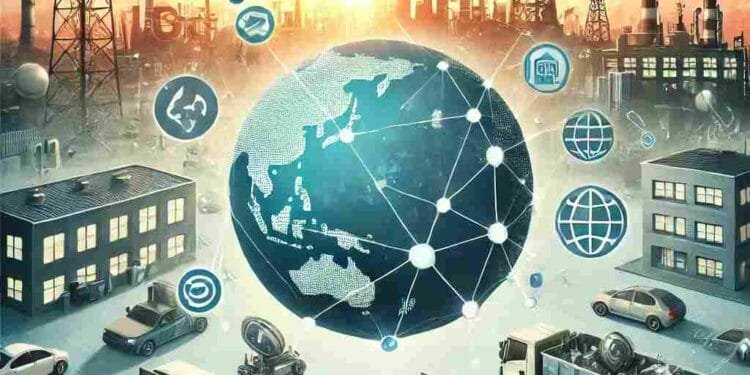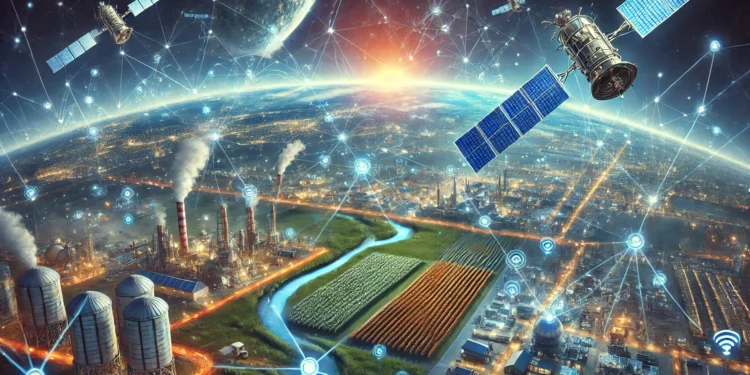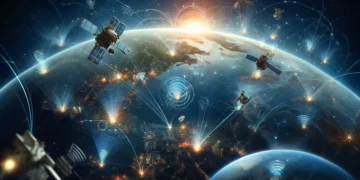The modern world continues to build more and more of its processes on efficient connectivity, and IoT satellite communication effectively fills the voids created by terrestrial networks. As a transformative technology, this holds incredible benefits, particularly for automotive firms pursuing high-level infotainment systems and for industries with distributed or distant assets and workers to connect. As IoT satellite communication adopts the latest advancements in innovation, IoT satellite solutions guarantee coverage that never ceases, are always dependable, and cover the entire global sphere.
This article continues analyzing the potential of satellite communication and focuses on its utilization for connected cars and remote industries. Most attention is paid to the fact that satellite networks make it possible to optimize processes, increase productivity, and develop new technologies.
What Is IoT Satellite Communication?
IoT satellite communication connects the Internet of Things, satellite technology for devices, vehicles, and industries, with the world. Satellite communication differs from most networks, which usually operate through physical cables to join distinct parts. However, it creates a satellite network to facilitate continuous data transmission regardless of geography’s challenges.
This technology is crucial for industries that frequently establish connections to perform duties and make decisions on the fly, such as the automotive and remote industries. For instance, IoT satellite solution integrated cars can exchange data and information on navigation, diagnosis, and safety to other connected vehicles or fleets.
Recent Statistics
According to the latest studies, the Internet of Things Satellite market is anticipated to expand at a CAGR of 15.7% from $5.8 billion in 2022 to $22.6 billion in 2032 due to the increasing need for reliable connectivity in rural and nomadic areas.
How the Internet of Things Satellite Communication Works
Internet of Things satellite communication uses GEO and LEO satellites to create a secure connection. These satellite networks connect IoT devices and control centers to facilitate real-time monitoring and controlling.
Key features of this technology include:
- Global Reach: It focuses on coverage, including the oceans, mountains, and deserts.
- Seamless Data Transfer: Real-time data exchange defines the best performance and safety.
- Scalable Solutions: Regarding specific industry requirements, satellite IoT solutions can be customized.
Applications of Satellite Communication
1. Connected Cars
For automobile manufacturers, satellite communication remains the foundation of the new generation of automobiles. It uncovers the various opportunities connected cars can offer and depends on modern technologies like the Non-Terrestrial Network (NTN).
- Navigation and Traffic Management: Satellite networks guarantee navigation services twenty-four hours a day, seven days a week, including in rural or least developed regions.
- Diagnostics and Over-the-Air Updates: The system allows automakers to observe how their vehicles function and even provide real-time software enhancements.
- Vehicle-to-Everything (V2X) Communication: In many cases, communication between cars and infrastructure will be relevant in reducing and/or avoiding accidents on roads and easing traffic jams.
These capabilities will become relevant in future car development, especially since in-vehicle NTN connectivity is expected to go global by 2027-2028.
2. Remote Industry Operations
IoT satellite services are the only means of access for several industries in difficult-to-access areas. Transportation and logistics, manufacturing and production, oil and gas, mining, farming, and fisheries all require steady information and operational management.
- Asset Tracking: Satellite IoT solutions can help businesses track equipment, machinery, and vehicles across vast regions.
- Workforce Connectivity: Remote teams can collaborate safely and efficiently using both voice and text communication.
- Environmental Monitoring: Weather patterns, air quality, and other environmental factors play an essential role in business operations; industries can compile and use data to enhance efficiency.
3. Private Satellite Networks
Private satellite network solutions are custom-made to meet the specific needs of companies that need a private and secure communication network with the scalability and flexibility to meet their business’s growth needs. These networks are well suited, especially for industries dealing with large volumes of data that should be kept from unauthorized people or industries operating in very specialized fields.
By adopting private satellite networks, organizations can:
- Preserve the confidentiality, integrity, and availability of data.
- Maximize and schedule the communication connections in line with specific operational demands.
- Improve scale solutions suitable to meeting changing business needs.
4. Non-Terrestrial Network (NTN) Connectivity
NTN connectivity is a blend of cellular networks, Wi-Fi, and broadband satellite links, which have the highest reliability standard. This hybrid synchronization approach also ensures that businesses and vehicles remain connected to each other at all times and places. NTN is especially suitable for connected cars and industries where high-speed data transmission with low latency is required.
Advantages of IoT Satellite Communication
1. Uninterrupted Coverage
IoT satellite communication offers a reliable network connection, whereas terrestrial networks can hardly provide one. This makes it highly useful for connected cars moving through rural or deserted areas and for industries comprising plants located in remote areas.
2. Scalability
Satellite IoT solutions are scalable, meaning they are made to expand as a business grows. They can be used individually or as a package to meet any individual or company’s vehicle connectivity needs, including fleets.
3. Enhanced Efficiency
Satellite communication optimizes its functions in industries by connecting with systems to monitor activities and provide information to make decisions. In the same way, for vehicles, it improves safety and convenience through such capabilities as V2X or over-the-air (OTA) updating.
4. Affordable Innovation
Satellites have evolved in recent years; therefore, IoT satellite solutions are less expensive. The small size of terminals and sensible structures of the businesses make it possible for them to implement these technologies while keeping them budget-friendly.
Future Prospects for Satellite Communication
- The future of satellite communication is, therefore, set to grow due to development in satellite technology and increased uptake across several sectors. Key trends shaping the industry include:
- Integration with 5G Networks: The application of 5G and satellite IoT will bring new opportunities for achieving breakthroughs in data transfer rate with low latency.
- More innovative Terminals: Advancements in satellite terminals are expected to continue. These features include the installation sizes of the devices, which will eventually lead to satellite terminals becoming more deployable and adopted.
- Expansion of NTN Connectivity: As the use of NTN solutions accelerates, connected automobiles and industries will experience further enhancement in reliability and performance.
Conclusion
Internet of Things satellite communication is a complete paradigm shift for vehicles and industries’ communication needs, offering reliability, scalability, and efficiency. To automobile makers, it guarantees that connected automobiles keep on working and are protected wherever they are. Resource-intensive industries often located far from various operational centers can facilitate adequate remote asset and workforce supervision and enhance efficiency with implied innovation encouragement.
While global connectivity increases even more in the future, satellite networks, private satellite networks, and satellite IoT solutions will only become more critical, in an increasingly connected world, IoT satellite communication remains crucial in everything from linking cars to improving manufacturing processes.












